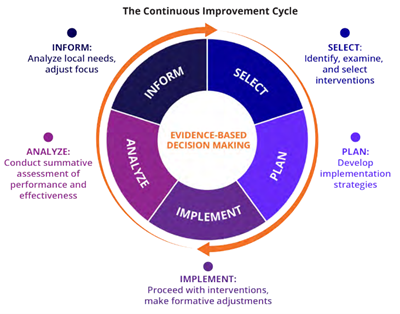School Improvement through the Continuous Improvement Process
The Continuous Improvement Process (CIP) is rooted in evidence-based decision making and helps organizations improve through a careful examination of need and resources, proper selection of interventions based on the needs, a planning phase of strategies to be utilized, development, implementation of strategies (with adjustments), and an efficacy analysis of the strategies and systems deployed.

Schools and districts analyze local needs and identify a focus. They collaboratively participate in a comprehensive needs assessment, where they investigate the effectiveness of previously implemented strategies and supports, analyze various contextual data including student performance, culture and climate, and teacher effectiveness data, and identify priority performance needs. Once the needs assessment process is complete, schools then begin to engage in a root cause analysis to identify root causes for identified problems of practice. At this juncture, schools and districts are ready to move into Phase 2- Select.
Schools identify, examine, and select interventions. If the school is planning to use an intervention they previously engaged in, they will present data on its effectiveness. Otherwise, it is incumbent upon the school to ensure that that intervention will be effective in their local context. This happens as a part of the Root Cause Analysis process within ASP development. Once there is a clear understanding of what the identified performance needs are, how they came to be, why they may exist, and schools have identified interventions, they move into Phase 3- Plan.
Schools develop implementation strategies. During this period the identified evidence based best practices/interventions that will support their prioritized performance needs and foster school improvement are thoroughly examined and elaborated upon. Schools select two to three strategies per goal. They delineate the necessary steps required to successfully implement this strategy throughout the year. These action steps occur on a cyclical basis, in alignment with interim goals. This concludes the development phase of the ASP process, that happens prior to the start of the school year. Once the initial plan has been approved, schools can successfully move into Phase 4- Implement.
Schools move forward with implementing their ASP. They are engaging in the strategies previously identified to support their interim and overarching goals. During this time, schools may pivot or adjust course based on formative data they receive regarding the success of implementation. This leads to Phase 5- Analyze.
Schools engage in quarterly progress monitoring to analyze data relative to their interim goals, done through reflective conversations. Asking questions such as: are you progressing toward meeting your overarching goal? How do you know? What data indicates this? Are your current interventions (strategies) effective? How do you know? What shifts need to be made at this time? Progress monitoring occurs at the conclusion of a cycle and cycle dates are aligned to interim goals.
Once Phase 5 is complete, schools restart the CIP.
The New Jersey Department of Education has adopted multiple frameworks for school and school districts to initiate the CIP: New Jersey’s Tiered System of Supports (NJTSS) and the Annual School Planning System.
 Official Site of The State of New Jersey
Official Site of The State of New Jersey